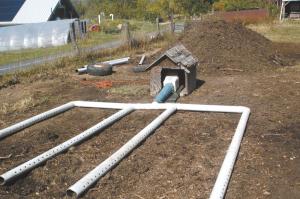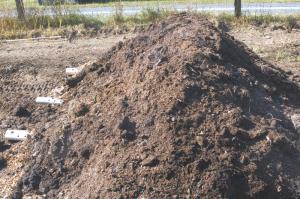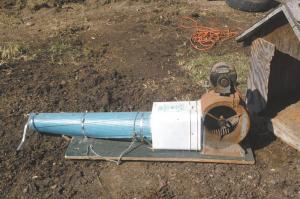2018 - Volume #BFS, Issue #18, Page #10
[ Sample Stories From This Issue | List of All Stories In This Issue | Print this story
| Read this issue]
No Turning Required With “Static Pile” Composting
 |
 |
 |
He uses inexpensive used parts and, once set up, the system requires very little labor.
Armour, who raises organic vegetables and needs a regular supply of organic compost. Instead of buying it, he set up his own system 2 1/2 years ago. Parts include a fan, pvc pipe and a timer.
Static composting requires air blown through the pile, so he started with a used squirrel cage furnace fan. He used a square plastic bucket and some aluminum sheeting to funnel air from the fan to 4-in. dia. pvc pipe.
He used four 30-ft. lengths of pipe connected to the cross pipe “manifold”. The pipes are spaced far enough apart so that he can drive a tractor with a bucket between them to build the pile and remove the finished compost.
He first covers the pipes with wood chips so that when he scrapes out the compost he knows when to stop before digging into the pvc pipes.
“The key thing is the timer used to turn the fan on and off. If the fan is running all the time the pile won’t heat up,” Armour explains. He experimented with the time while monitoring the pile’s temperature. To keep it at about 160 degrees he set the timer to repeatedly turn the fan on 3 min., then off 20 minutes. The time will vary according to the size of the pile and the material in it. He uses an Autopilot Analog Recycling Time (APCTART) that retails for about $75.
Armour adds horse manure to the compost pile in the summer and fall. He leaves his dump trailer at a horse farm and picks it up when full. If it’s dry, he uses a water sprinkler to add moisture as he builds up the pile to about 6 ft. tall. To avoid the top edge from not getting warm enough, he covers the pile with about 8 in. of finished compost. He leaves the fan on for two weeks, then lets the pile rest for another two weeks. The finished pile is about 25 percent smaller and ready to be used or stored under a UV-resistant, semi-impermeable fabric that protects it from rain, yet allows it to release steam.
“I used to move it when it was finished, then I got wise and figured I’d just take it from there as I needed it. I have two piles next to each other and move the fan, back and forth,” Armour says, so he has a supply of compost being made, while another pile is in process. “I don’t screen the compost. There really isn’t any need to screen it. My finished compost still looks like manure, but it doesn’t smell like manure.”
He has offered local workshops on static composting and often makes these suggestions: Put the fan in some kind of structure to protect it, and be creative with materials you have on hand to connect the fan to the pvc pipes.
He plans to build a wooden unit to replace the plastic bucket, for example. Armour notes he has made compost in the winter, but it takes longer. He normally waits until spring to use horse and cattle manure gathered during the winter.
“This could be downsized. You can scale it to whatever size you need. Anyone can make compost on their homestead,” he says.
Contact: FARM SHOW Followup, Jay Armour, Four Winds Farm, 158 Marabac Rd., Gardiner, N.Y. 12525 (ph 845 255-3088; http://users.bestweb.net/~fourwind/; jarmour@bestweb.net.)

Click here to download page story appeared in.

Click here to read entire issue
To read the rest of this story, download this issue below or click here to register with your account number.




